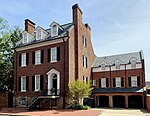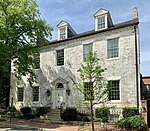Transformers (sculptures)
Transformers are two metal sculptures depicting characters from the Transformers media franchise that were installed outside of the Georgetown home of Newton Howard, a brain and cognitive scientist who is a professor at Georgetown University in Washington, D.C. The two-ton (1,814 kg) sculptures were made from recycled motorcycle and car parts and depict Bumblebee and Optimus Prime. They were installed in January 2021, leading to a mixed reaction from locals and legal challenges from the Old Georgetown Board and local Advisory Neighborhood Commission. Howard's work with artificial intelligence and implant prosthetic technology inspired him to have the sculptures commissioned by an unnamed artist. Additional sculptures are inside his house, located on Prospect Street NW in the Georgetown Historic District. Due to regulations in historic districts and overseeing public and private designs by the Old Georgetown Board, Howard was told to remove them. He was eventually granted permission to have the sculptures displayed temporarily.
Excerpt from the Wikipedia article Transformers (sculptures) (License: CC BY-SA 3.0, Authors).Transformers (sculptures)
Prospect Street Northwest, Washington Georgetown
Geographical coordinates (GPS) Address Nearby Places Show on map
Geographical coordinates (GPS)
| Latitude | Longitude |
|---|---|
| N 38.905812 ° | E -77.070651 ° |
Address
Prospect Street Northwest 3614
20057 Washington, Georgetown
District of Columbia, United States
Open on Google Maps










